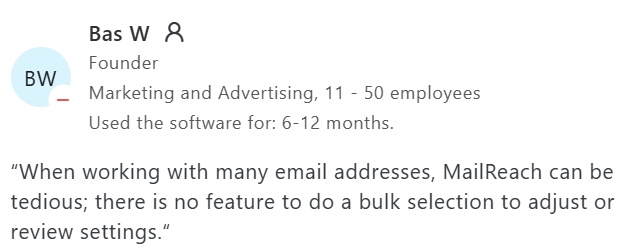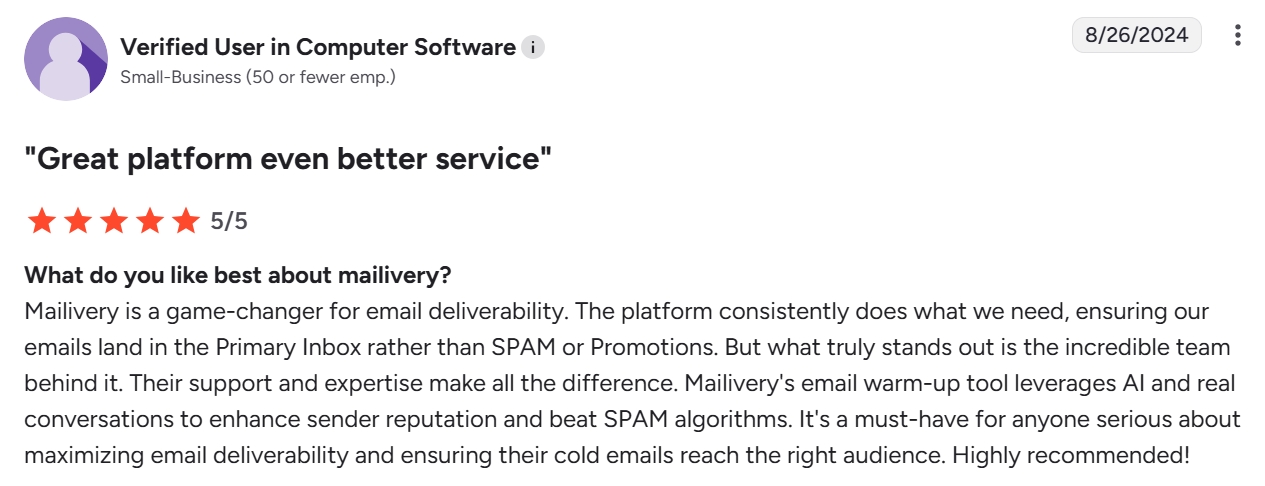.png)
You want the facts, no fluff. So, what’s the real story with Mailreach?
We went through hundreds of user reviews from platforms like G2, Capterra, Reddit, and Voy Media to break down what users truly think.
From standout features to areas that need improvement, we’ll give you the full picture of how Mailreach performs in real-world scenarios.
Plus, we’ll explore how it compares to Mailivery, a rising star among email warm-up tools, known for offering better scalability, control, and a wider feature set.
Here’s what you need to know:
Mailreach gets strong marks for ease of setup. Whether you’re connecting via SMTP or API, onboarding is smooth and straightforward. Users consistently mention how easy it is to get started, even without technical experience.

No dev time. No steep learning curve.
The dashboard is clean and focused. You’ll find clear visual indicators for warm-up progress, spam placement, and domain health, all front and center.
Many users have seen significant improvements in inbox placement after using Mailreach.
The warm-up engine is built to mimic realistic sender behavior, gradually scaling volume to build trust with providers.
The improvement is noticeable, especially for newer inboxes or recently parked domains.
Mailreach’s pay-per-inbox model appeals to solopreneurs and small agencies. The pricing is predictable and simple. No hidden fees or complex packages.
For smaller setups, it feels manageable and easy to forecast month to month.
Mailreach users mention how responsive the support team is.
If support matters to you, Mailreach delivers on that front.
While the core focus is on warming, Mailreach comes with helpful extras:
These features make it a more complete deliverability companion for teams who want a bit more than just inbox warming.
Most users find the setup smooth. But if you're using a less common email provider, you may hit extra steps around authentication or DNS.
Once it's set, it runs well. But not every setup is friction-free.
Mailreach often delivers perfect scores in internal spam tests. But some users say their actual campaign performance doesn’t always match those results.
The takeaway? Lab environments don’t always reflect how your emails will behave out in the real world.
For small teams, pricing is reasonable. But once you start managing a higher volume of inboxes, the per-mailbox model starts to add up.
Agencies or platforms with large sender pools may find themselves looking for a more scalable structure.
Mailreach covers the essentials, but power users may find themselves wanting more.

Mailivery is the warm-up platform more and more users are turning to when they want more control, better scalability, and a fuller feature set. It’s simple enough for founders. Powerful enough for agencies.
You don’t need to be technical to use it. But if you are, it has the depth to grow with you.
No per-inbox pricing here. You pay based on daily warm-up volume.
Whether you're warming three inboxes or three hundred, the cost remains predictable. That alone makes it a smart pick for agencies juggling multiple clients or domains.
Mailivery doesn’t gate features behind pricing tiers. You get the full toolkit from day one:
No upgrades, no nickel-and-diming.
This is where Mailivery really expands the definition of what a warm-up tool should be. It doesn’t just prep your inbox. It watches your deliverability like a hawk.
You get real-time alerts on domain reputation, blacklist hits, and spam placement trends.
And if something goes wrong, it doesn’t just notify you. It takes action, rescuing emails from spam, adjusting patterns, and helping protect your sender score in real time.
When you reach out for help, you're not just getting a canned response. You’re talking directly to the product team. Mailivery users often influence new features and updates. Feedback isn’t just welcomed, it’s implemented.

Mailivery only uses SMTP and IMAP. No browser bots. Every seed inbox is monitored and active. Engagement is natural, credible, and built to be undetectable by the increasingly strict filters of Gmail, Outlook, and others.
This isn’t just more reliable. It’s safer.
If you're building on top of Mailivery, say you're embedding it into your SaaS, then the API gives you detailed control over ramping logic, templates, reporting, and engagement behaviors.
But if you're not technical? No problem. Everything is still easy to manage through the dashboard.
Here’s how the two tools compare depending on what you need:
If you’re testing the waters with a few inboxes and need a warm-up tool that’s simple to use, Mailreach does the job. It’s stable, and well-supported.
But if you’re thinking ahead, scaling teams, adding clients, or building cold email into your growth engine, Mailivery offers more firepower, more flexibility, and better value across the board.
Warm-up tools are no longer optional. Whether you’re a founder sending your first cold email or an agency managing dozens of domains, how you warm up can make or break your campaigns.
Pick the tool that fits today, and won’t slow you down tomorrow.
